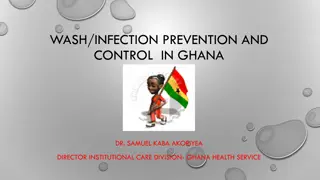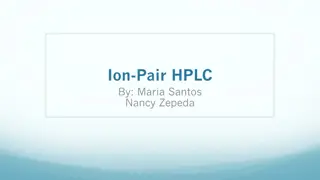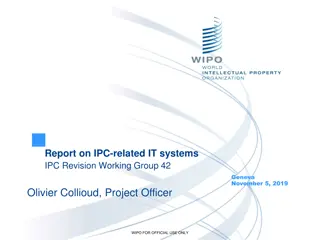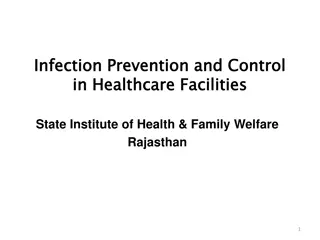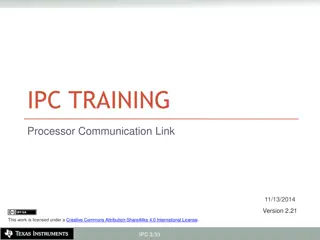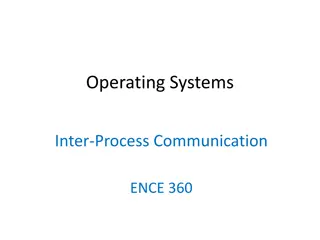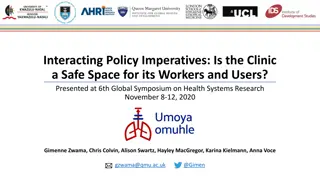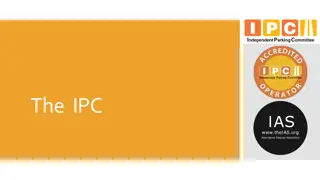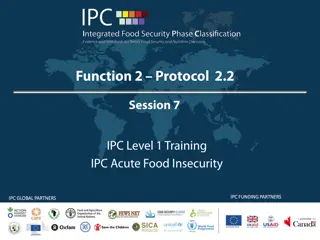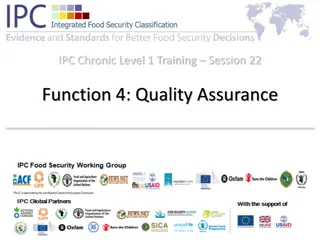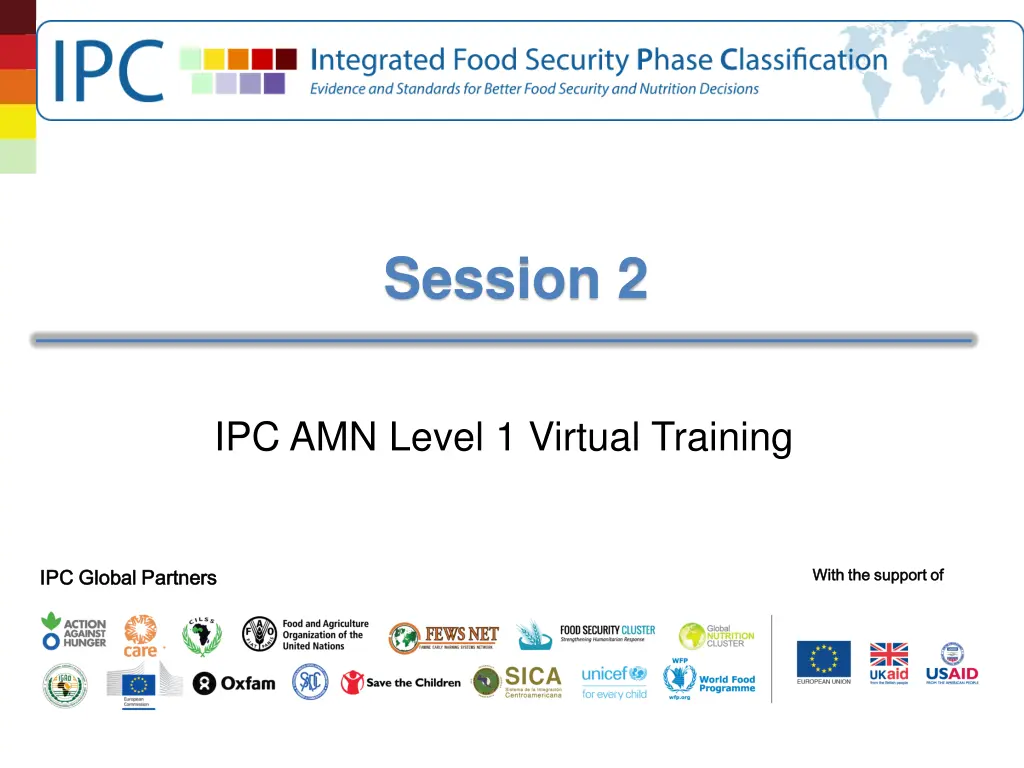
IPC AMN Criteria for Outcome Indicators in Global Partnerships
Learn about the IPC AMN criteria for outcome indicators in global partnerships, including the classification based on GAM, sources of outcome data, and guidelines for using survey results. Understand the importance of representative surveys and anthropometric data validation.
Download Presentation

Please find below an Image/Link to download the presentation.
The content on the website is provided AS IS for your information and personal use only. It may not be sold, licensed, or shared on other websites without obtaining consent from the author. If you encounter any issues during the download, it is possible that the publisher has removed the file from their server.
You are allowed to download the files provided on this website for personal or commercial use, subject to the condition that they are used lawfully. All files are the property of their respective owners.
The content on the website is provided AS IS for your information and personal use only. It may not be sold, licensed, or shared on other websites without obtaining consent from the author.
E N D
Presentation Transcript
Session 2 IPC AMN Level 1 Virtual Training IPC Global Partners IPC Global Partners With the support of With the support of
IPC AMN Criteria for Outcome Indicators 3
IPC AMN Criteria for Outcome Indicators Acute malnutrition is the outcome of the IPC Acute Malnutrition classification IPC AMN classification is based on the following outcome indicators: GAM based on WHZ among children 6-59 months GAM based on MUAC among children 6-59 months The outcome indicators will typically come from the following sources: Representative surveys Sentinel sites Screenings Minimum criteria have been set for each source of data No area will be classified unless there is outcome data that meet this minimum criteria 4
IPC AMN Criteria for Outcome Indicators Representative Surveys (1/4) Surveys should be: a) Representative at the unit of analysis b) Validated by an in-country authority c) From the same season of analysis, if there is seasonality If surveys are validated with caution : Use calculated prevalence if WHZ SD is >1.2 Use observed prevalence if WHZ SD is <1.2 5
IPC AMN Criteria for Outcome Indicators Representative Surveys (2/4) If there is no survey validation mechanism in place in a country, survey results should be used based on the SMART plausibility check results: SMART plausibility check score Decision <15 Use without any restrictions Treat it like survey validated with caution 15-25 >25 Do not use 6
IPC AMN Criteria for Outcome Indicators Representative Surveys (3/4) Anthropometric data from other surveys must also meet all above criteria and must also follow the guidance below: Sampling design is done at the level of the unit of analysis A minimum of 25 clusters per unit of analysis If 20-24 clusters: seek expert advice from SMART technical group or UNICEF/nutrition cluster If <20 clusters: do not use 7
IPC AMN Criteria for Outcome Indicators Representative Surveys (4/4) If surveys are covering only part of the unit of analysis, only the area covered by the survey may be classified MUAC from representative surveys at the unit of analysis should follow the guidance for surveys For Simple Spatial Surveying Method (S3M) surveys: Administrative level with at least 20 clusters/sites and at least 200 children can be used as a unit of analysis Anthropometric data from S3M must pass the SMART plausibility check 8
IPC AMN Criteria for Outcome Indicators Sentinel Sites (1/2) Sentinel sites are usually purposively selected based on some pre-set criteria Sentinel sites can be community based or facility based but only outcome data from community based sentinel sites should be used in IPC AMN Prevalence will be calculated by taking average from all sites in a given unit of analysis (no weights will be applied) No trend data will be used in the classification however trend data may be used (same season in the previous year(s)) in the interpretation of the results 9
IPC AMN Criteria for Outcome Indicators Sentinel Sites (2/2) Data from sentinel sites will be subjected to the same plausibility checks as data from the surveys Repeated MUAC screening data from the same areas (e.g. for referral purposes) should be treated as sentinel site data Data can be either GAM based on MUAC or GAM based on WHZ but should come from children 6-59 months There must be 5 sites per unit of analysis with 200 total observations if the area is pastoral, 5 sites with 100 observations is acceptable 10
IPC AMN Criteria for Outcome Indicators Screening (1/4) The screening should have been carried out during the same season of analysis MUAC screening should have age and sex data and MUAC reading should be recorded in numbers and not in color categories i.e. 113mm, etc. and not by green, yellow, and red. MUAC screening can be: 1. exhaustive at the unit of analysis level (e.g. screening child health days, vaccination campaigns, etc.) 2. done at the selected sites within a unit of analysis If the screening is exhaustive, there must be at least 80% coverage 11
IPC AMN Criteria for Outcome Indicators Screening (2/4) If screening is done in selected sites: the sites may be selected randomly or purposively (for variability purposes e.g. to represent each livelihood zone in a district) but the selection of children within the sites should either be random or exhaustive (at least 80% coverage) At least 3 sites per unit of analysis and at least 200 children per site prevalence estimates from each screening site should be calculated separately If all prevalence estimates converge and indicate the same Phase, it may be taken as the final Phase If not, final Phase will be determined using consensus If there s no consensus, this data will not be used in the analysis 12
IPC AMN Criteria for Outcome Indicators Screening (3/4) Quality check for MUAC screening: Age distribution Sex ratio Digit preference SD: good: <13.0; acceptable: 13.0-<14.0; poor: 14.0-<15.0; unacceptable: >15.0 Age distribution must not be skewed Check age distribution of young (<2 yrs) and old (>2 yrs) (e.g. using the CDC Excel spreadsheet) and adjust as needed 13
IPC AMN Criteria for Outcome Indicators Screening (4/4) If screening is done on a monthly basis, the latest information from the season of analysis should be used Data from ad-hoc rapid assessments conducted to quickly assess the situation should be treated as screening The relationship between WHZ and MUAC in the area of analysis and contributing factors must be taken into account when making Phase classification with MUAC 14
IPC AMN Criteria for Outcome Indicators other options In the event that there is no current data (surveys, sentinel sites, or screening), the following can be used: a) Disaggregated survey data from a higher administrative level b) Recent data from representative surveys c) Historical data from representative surveys d) Survey estimates from similar areas 15
Disaggregated survey data from a higher administrative level Disaggregated survey data refers to surveys conducted at the higher admin level but data reanalyzed to get estimates for lower admin levels Decision on the use of estimates and the reanalysis is based on the Design Effect (DEFF) If DEFF at the higher admin level <1.3 same estimates can be applied to lower levels (no need for reanalysis) If DEFF at the higher admin level is 1.3 and <1.7, need to reanalyze Need to have at least 5 clusters and 100 children per unit of analysis DEFF of the reanalyzed estimates should be DEFF <1.3 If DEFF is 1.7, lower and upper CI and point estimate should be used along with convergence of evidence 16
Recent survey Ideally, surveys used in IPC AMN analysis should be carried out in the same season of the IPC AMN analysis However, if there is a recent survey just before the current season of the analysis, it can be used in the absence of other outcome data. E.g. of a recent survey: current season of analysis in an area is lean (June Sept) but the survey was conducted in May Analysis should show that there is no big changes in the survey estimate i.e. the GAM is relatively still the same despite change in seasonality Usually surveys conducted within the 6 months preceding the analysis 17
Historical data If there is no current data (either on WHZ or MUAC) then, historical WHZ data from surveys can be used to extrapolate current IPC AMN Phase At least 2 data points from similar years in the past 5 years for the same season Surveys should be representative at the unit of analysis No big changes in the population characteristics, contributing factors, etc. should be shown in the analysis 18
Survey estimates from similar areas In the absence of other outcome data, WHZ estimate from a survey from a similar area can be used Population characteristics between the unit of analysis and that of the survey area must be similar Survey must be from the same season Similar GAM estimates in the past, no recent changes in population characteristics or contributing factors, etc. should be shown in the analysis 19
Decision tree for IPC AMN outcome indicators Current or recent survey Current surveys > recent surveys Other current data Reanalyzed survey data > Sentinel sites > screening Historical data Surveys Data from similar area Surveys 20
Session 2.1 21
Plenary Q&A and discussion 10 min The facilitator would randomly select someone (using a random number table) and a him/her to explain about a particular IPC AMN key parameter. 22
Groupwork 10 min In your group, discuss: 1) What is seasonality? 2) Can acute malnutrition season differ from food security season? If yes, why? If not, why not? Be ready to present in plenary! 23
Session 2.2 24
Plenary Q&A and discussion 10 min Based on the results of the quiz exercises. 25
www.IPCinfo.org The End IPC Global Partners IPC Global Partners With the support of With the support of




